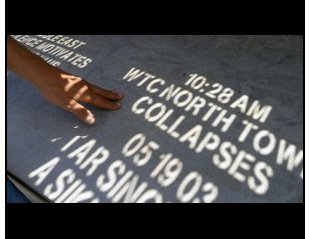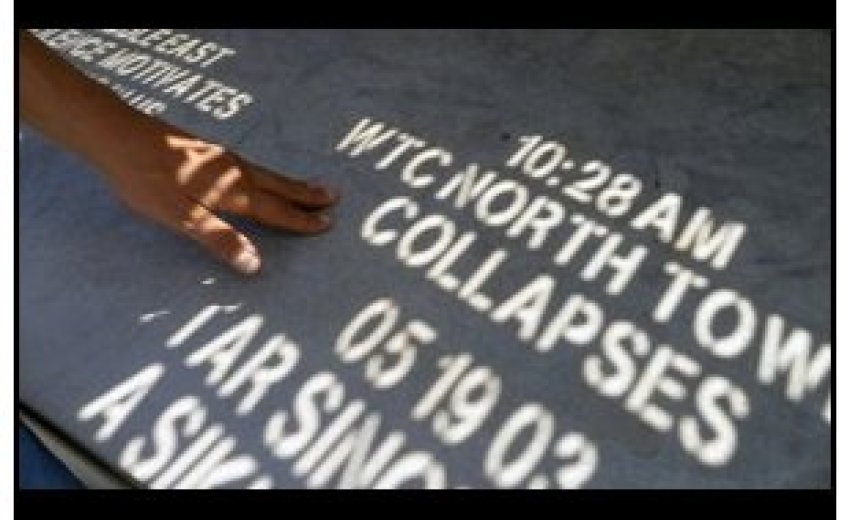 |
| ( Tamara Lush / Associated Press ) - In a In a May 10, 2011 photo, Joseph Manny passes his hand over a phrase etched into steel on a Sept. 11 memorial in Phoenix. The monument was created by etching 54 phrases in a circular piece of steel that captured what happened on Sept. 11 in New York and Phoenix, some stating facts and some stating opinions. It’s those opinions on the memorial that have touched off a struggle in Arizona over how Sept. 11 should be remembered. |
Rivaling stories etched in steel
PHOENIX — Matthew Salenger etched 54 phrases in a circular piece of steel, building Arizona’s Sept. 11 memorial one story at a time. He wanted everyone’s story to be told.
Phrases like “10:28 a.m. WTC North Tower Collapses” stated undisputed facts. Then there was “Must Bomb Back” and its polar opposite: “You Don’t Win Battles of Terrorism With More Battles.” Gary Bird, a businessman and Arizona’s sole Sept. 11 victim, was listed. So was a Sikh who was killed in a hate crime outside Phoenix, four days later.
Salenger thought that all of those thoughts could coexist peacefully on a public memorial. He was wrong.
“I think we overestimated how much respect people would have for each other and their views,” says Salenger, who was one of the monument’s three designers. “People didn’t want to see something they don’t agree with in public.”
The rivaling stories on the memorial touched off a bitter, years long struggle in Arizona over how Sept. 11 should be publicly remembered. Here, as in the rest of the United States, there are opposite and diverging opinions about tolerance and patriotism, hate and peace. And on the Phoenix memorial, those opinions are etched in steel, side by side.
The events of that day, and how to remember them across the years, have always been subject to multiple interpretations. At ground zero in New York, designers, families and politicians wrenchingly debated how to arrange the names of the dead, whether to include the company they worked for and the tower floor they died on, whether and where to put thousands of unidentified remains anywhere at all. In Pennsylvania, families objected to an original crescent shape that formed the memorial to the 40 victims of the hijacked jet that crashed in Pennsylvania, saying the design paid tribute to Muslim extremists because it was shaped like a Muslim symbol.
Phoenix’s monument — named, fittingly, “Moving Memories” — is no different. It sits in a quiet memorial park in downtown Phoenix, alongside dozens of other monuments to wars, veterans and even dead police dogs and early state pioneers. While most of the other monuments in the park are straightforward — dates, names, phrases like “triumph of courage” — the Sept. 11 memorial stands alone in its ambiguity.
The memorial’s etched phrases shine on the concrete below at different times of the day, depending on the sunlight. Early in the morning, only certain phrases are visible. They are all clearest at noontime, and as the blazing Arizona sun begins to dip westward, some phrases become fuzzy and unreadable.
Joseph Manny sat there recently, running his hand along the concrete where the reflected phrases glowed in the light. Some of the statements — and facts — were so powerful that Manny sometimes got choked up while reading them.
“Going across the timeline and when it gets to where the south tower and the north tower fell, it’s just...” Manny’s voice trailed off.
Manny doesn’t think any of the phrases should be changed or removed from the memorial. “There is nothing detrimental here,” he said. “This is just what was going on in America in this reality at that time.”
 |
| ( Ross D. Franklin / Associated Press ) - In a May 23, 2011 photo, Sukhwinder Singh adjusts flowers at the memorial for his father, Balbir Singh Sodhi, in Mesa, Ariz. Singh’s father was shot and killed in front of the family-owned gas station as he was placing flowers at a makeshift memorial the family set up shortly after the 9/11 attacks in 2001. The Sikh was killed during the anti-muslim backlash after the 9/11 attacks. Some have objected to including Balbair Singh Sodhi’s name on a Phoenix Sept. 11 memorial, saying he was not a victim of the attacks, but his family takes issue with that statement. Rivaling stories on Phoenix’s Sept. 11 memorial touched off a bitter, years-long struggle in Arizona over how Sept. 11 should be publicly remembered. |
In this reality. That’s the question of interpretation that can cause such dispute. But Harriet Senie, who is writing a book about public memorials, says controversial debate over memorializing the world’s biggest events is normal, even welcome.
“Memorials are deeply important because they do impact personal and national identity,” said Senie, director of museum studies at City College in New York. “We should kind of expect it to be a conversation. I’m not so sure it’s a bad thing, as long as it’s a contribution and not a diatribe.”
The key, she said, is that public artists or communities considering a memorial should decide whether the structure will stand the test of time.
“These are ideas held by specific individuals at a specific point in time, what kind of sense are they going to make in 50 years?” she said.
In Arizona, even when the ideas were set in steel, they changed.
“A lot of what it represents is in symbols and metaphors,” says Shelley Cohn, one of 30 members of the memorial commission. “It was meant to be poetic, and for people to interpret it on their own.”
Before Salenger was selected, the memorial commission hired a historian, who compiled a thick binder filled with newspaper clippings of the attacks and what was happening in Arizona around that time. Salenger and his team pulled 300 statements and bits of sentences from news clippings, and incorporated them into the memorial’s designs.
The commission — which was comprised of Democrats and Republicans, firefighters, police, moms of soldiers and a 9/11 family member, sifted through all of the phrases “statement by statement,” Cohn says. “We took this very seriously.”
As the commission read aloud each proposed statement, Salenger recalls, some members would chime in: “I didn’t feel that way.” Others would add: “I did feel that way.”
Eventually, they agreed on 54 statements, and the monument was built. Before it was unveiled, all the phrases were printed in the local newspaper. No one spoke up. But a few days after the memorial was dedicated on the fifth anniversary of the attacks, a man named Len Munsil, who was running for governor, held a news conference: Some phrases, he said, were inappropriate and should be removed.
Munsil didn’t win the election, but anger over the monument remained.
“It should have been the straight facts,” says John Kavanagh, a former Port Authority policeman in New York who is now an Arizona state representative. “Tell the story, which was that it was a day of infamy. A sad day. This monument goes far beyond communicating that.”
Kavanagh wasn’t in New York at the time of the 2001 attacks, although he said that he knew many of the Port Authority of New York and New Jersey officers who died at the World Trade Center. He did, however, respond to the first trade center bombing in 1993, and retired to Arizona soon after.
The phrase “You don’t win battles of terrorism with more battles” is a “slap in the face” to the military, Kavanagh said. And he thinks another phrase — “Foreign-born Americans afraid” — had no place on the memorial.
“To see it turned into a place where people came to argue instead of remembering the day of Sept. 11 was upsetting to me,” he says. “This was liberal politics and political correctness run amok by well-intentioned people who were out of touch from the true sentiment of Arizona residents.”
In 2008, Kavanagh, a Republican from suburban Phoenix, filed a bill to remove all of the slogans and replace them with a straight timeline. It was defeated in the state Senate. Also that year, the 30-member committee reconvened to remove two of the slogans — “Erroneous U.S. air strike kills 46 Uruzgan civilians” and “Terrorist organization leader addresses American people.” In their place: “George W. Bush Declares Patriots Day,” and “We Will Never Forget.”
Says Cohn, the committee member: “What we learned was that people didn’t understand the memorial at all. They wanted something more factual. But it speaks to the diversity of reactions to what went on. You can’t deny that.”
But the wrangling wasn’t over. This year, Kavanagh filed another bill to remove 11 of the phrases. It passed in both chambers.
People began calling Salenger at home. They wrote to the local newspaper and voiced their outrage on talk radio. Some accused him of giving al-Qaida leader Osama bin Laden credit for committing the attacks. Many of them, Salenger says, had never seen the memorial.
Before Kavanagh’s bill went to the governor’s office this spring, someone else stepped in: the brother of a Sikh man who was killed four days after Sept. 11 in Mesa, 20 miles outside Phoenix. The killer, who has since been convicted, mistook the man as Muslim because he was wearing a turban.
Kavanagh wanted the phrase “09 15 01 Balbir Singh Sodhi, a Sikh, murdered in Mesa” removed. Singh Sodhi wasn’t a Sept. 11 victim, he said. But Singh Sodi’s brother, Rana, takes issue with that assessment.
”We felt like my brother was also a victim of Sept. 11,” Rana Singh Sodhi says. “Why was my brother controversial?”
Singh Sodhi, who came to the United States from India with his family in 1984, said he had never had problems with discrimination prior to Sept. 11. Afterward, people began to mistake him and his brothers for Muslims.
Singh Sodhi explained all of this to Kavanagh during a meeting. He pleaded with the lawmaker to keep his brother’s name on the memorial. Kavanagh agreed.
”What do people want, do they want to rewrite history?” Singh Sodhi says. “This happened here in Arizona.”
On April 29, Gov. Jan Brewer vetoed Kavanagh’s bill. He has vowed to refile it.
___
EDITOR’S NOTE — Tamara Lush is traveling the country writing about the 10th anniversary of the 9/11 attacks. Follow her on Twitter at twitter.com/tamaralush.
EDITORS’ NOTE _ This is first in a regular series of stories examining how the country has changed in the decade since the Sept. 11, 2001, terror attacks.
© Copyright 2011 The Associated Press. All rights reserved.

